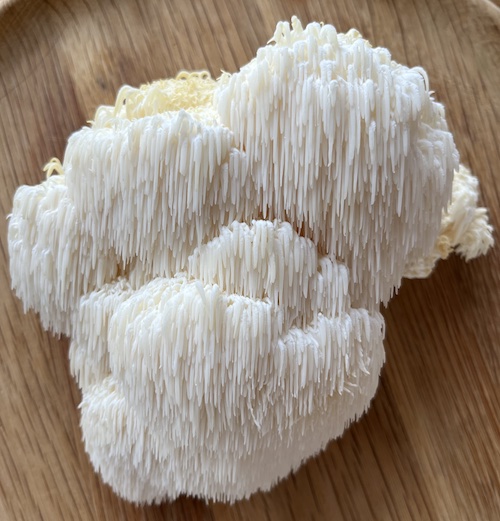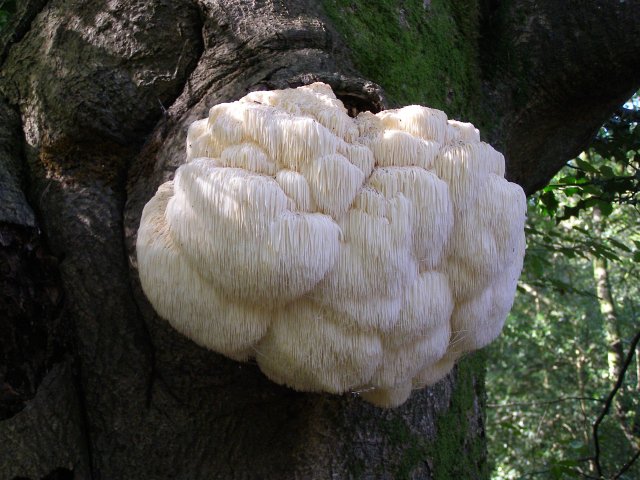Lion's Mane
Hericium erinaceus
Introduction:
The Lion's Mane Mushroom, scientifically known as Hericium erinaceus, is a distinctive gourmet and medicinal fungus belonging to the Hericiaceae family. Renowned for its unique appearance resembling cascading white icicles, this mushroom has not only captivated the culinary world but also garnered attention for its potential neurological benefits. Let's have a look at the Lion's Mane Mushroom, to better understand its biology, ecology, cultivation and potential health benefits.

Biology:
Taxonomy:
Hericium erinaceus derives its scientific name from Latin roots. "Hericium" refers to "hedgehog," "erinaceus" also means "hedgehog" in Latin, emphasizing the resemblance of the mushroom to the spines of a hedgehog. This unique nomenclature reflects the mushroom's distinct morphology. So technically its real English name is Hedgehog hedgehog!
Morphology:
The Lion's Mane Mushroom is characterized by its cascading spines that form a dense, globular structure. The spines are long, white, and hair-like, giving the mushroom its lion's mane appearance. The mushroom lacks a traditional cap and stem, and its entire structure is soft and edible when young.
Ecology:

Habitat:
Lion's Mane Mushrooms are typically found in North America, Europe, and Asia, growing on hardwood trees such as oaks and maples. They are saprotrophic, meaning they obtain nutrients by decomposing dead or decaying wood. Their ecological role involves breaking down lignin and cellulose, contributing to the recycling of organic matter in forest ecosystems.
Distribution:
While Lion's Mane Mushrooms have a natural habitat in temperate regions, they have gained popularity in cultivation due to their adaptability to various environments. Cultivation has allowed for a more consistent and widespread availability of this mushroom.
Cultivation:
Substrate:
Lion's Mane Mushrooms are cultivated on a variety of substrates, including hardwood sawdust, wood chips, or a mix of grains. They are known for their ability to thrive on different materials, making them suitable for both indoor and outdoor cultivation.
Cultivation Process:
- Substrate Preparation: Prepare and sterilize the substrate to create a favorable environment for mushroom growth.
- Inoculation: Introduce the mushroom spawn to the substrate, allowing the mycelium to colonize.
- Incubation: Provide optimal conditions for the mycelium to spread and fully colonize the substrate.
- Fruiting Conditions: Mimic natural conditions with proper humidity and fresh air exchange to induce fruiting.
- Harvesting: Harvest Lion's Mane Mushrooms when the spines are fully developed but before they begin to turn yellow.
Culinary Uses:
Lion's Mane Mushroom, with its delicate texture and subtle flavor, has found its place in various culinary traditions. Here are some popular culinary uses:
- Sautéed Lion's Mane: Sauté fresh Lion's Mane Mushroom in butter or olive oil with garlic and herbs for a simple and flavorful side dish.
- Stir-Fries and Noodles: Lion's Mane adds a unique texture to stir-fries and noodle dishes, absorbing the flavors of sauces and spices.
- Mushroom Steaks: Roast or grill Lion's Mane slices to create mushroom "steaks" with a meaty texture, suitable for vegetarians and meat-lovers alike.
- Mushroom Scramble: Chop Lion's Mane into small pieces and use them as a substitute for meat in a mushroom scramble or omelet.
- Broths and Soups: Lion's Mane is well-suited for broths and soups, infusing its subtle flavor into the liquid while maintaining its tender texture.
- Mushroom Tacos: Use Lion's Mane as a filling for tacos, adding a unique twist to this classic dish.
The versatility of Lion's Mane Mushroom in the kitchen, combined with its potential health benefits, has contributed to its popularity among chefs and home cooks alike. Whether enjoyed on its own or as part of a larger culinary creation, Lion's Mane adds a touch of elegance and nutritional value to a variety of dishes.
Potential to Improve Neuron Function:
Research on Lion's Mane Mushroom has garnered attention for its potential neurotrophic and neuroprotective effects. Some studies suggest that bioactive compounds found in Lion's Mane, such as hericenones and erinacines, may stimulate the production of nerve growth factor (NGF). NGF plays a crucial role in the growth, maintenance, and survival of neurons, making Lion's Mane Mushroom a subject of interest in neurological research.
While more research is needed to fully understand the extent of its effects, there is growing interest in Lion's Mane Mushroom as a potential dietary supplement to support brain health and cognitive function. It is important to note that individual responses may vary, and consulting with a healthcare professional is advisable before incorporating Lion's Mane supplements into one's diet.
Conclusion:
The Lion's Mane Mushroom, Hericium erinaceus, stands out for its distinctive appearance and potential health benefits. From its intriguing taxonomy to its ecological role and cultivation practices, this mushroom continues to capture the curiosity of enthusiasts and researchers alike. As our understanding of its neurological effects advances, Lion's Mane Mushroom remains a fascinating subject at the intersection of mycology and health sciences, offering both culinary delight and potential cognitive support.